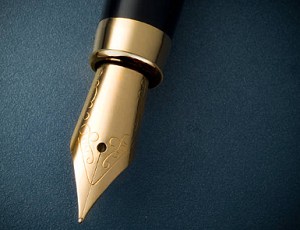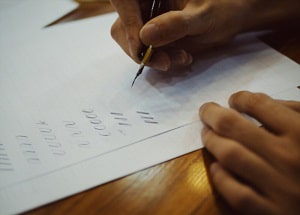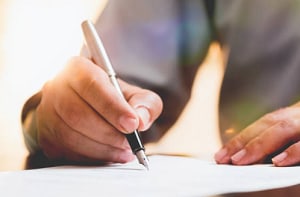Calligraphy is a sophisticated art of handwriting, presenting expressive, creative, and balanced proportions of texts and symbols. In ancient times, calligraphers would use dip pens, quills, and bottled inks to execute this art of decorative handwriting.
Complex as it may seem, many calligraphers and artists have studied this art form over the years. Much more so on how to write with a calligraphy pen and exhibit beautiful and harmonious calligraphy skillfully.
As contemporary calligraphy writing implements have emerged over time, calligraphy practice could not be more versatile. This allows aspiring artists to do calligraphy with a pen of their choice, such as fountain pens, brush pens, and markers.
Table of Contents
A Detailed Guide to Writing With a Calligraphy Pen
Writing with a calligraphy pen might seem intimidating, especially if you have just started learning calligraphy. The following guide and useful tips will help you create beautiful calligraphy effects whether you choose to write with a calligraphy marker or pen.
What to Prepare
- Calligraphy writing tool (brush pen, fountain pen, or marker)
- A smooth sketchbook
- Grid paper or pre-lined paper
- A pencil
- A ruler
Step 1: Choose Your Calligraphy Writing Tool
As a beginner, it is crucial to use a calligraphy pen that you are most comfortable with. Keep in mind that the right writing tools can get you started easily with calligraphy.
With that said, you may find your preferred calligraphy pens among markers, brush pens, fountain pens, and dip pens.
- Brush Pens: Brush pens with small tips are much easier to control and hence, they are suitable for beginners.
Compared to brush pens with a large tip, small-sized brush pens are more flexible and comfortable to use, especially when applying correct pressure for upstrokes and downstrokes. They arealso reliable for bouncy lettering and cursive script.
- Fountain Pens: These pens are among the popular tools for practicing contemporary calligraphy. They are simple with a similar feel to an ordinary pen, making it forgiving when producing precise lines and intricate strokes.
The nibs vary, but I recommend going for calligraphy fountain pen writing tools with medium nibs for better control and effortless applications.
- Markers: Markers have various nib sizes that work great for calligraphy practice. Look for the ones with solid felt tips or broad-edged markers since they are convenient to use and easy to control.
These markers are great for calligraphy amateurs when learning the basic strokes and elements of calligraphy. Plus, they are less expensive.
However, avoid chiseled-tip markers since they cannot render adequate pressure for downstrokes and upstrokes. Either you end up with bleed-throughs or uneven strokes.
- Dip Pens: Dip pens have the appearance and feel of a traditional quill and ink for calligraphy. However, these pens require controlled pressure to execute precise strokes.
Unless you are an advanced calligrapher or have mastered using fountain pens, I do not recommend dip pens if you are a beginner.
These pens need to be assembled properly. They also have nibs that require regular and proper cleaning to prevent clogging. Not to mention the correct ink combinations and paper type to make sure these pens work effectively.
Although dip pens may require a bit of a learning curve, it won’t hurt to try them when you are ready to challenge your calligraphy skills. When you do so, I suggest trying beginner dip pen sets.
Step 2: Start with the Basic Strokes
At this point, we are going to practice with a pencil and sketchbook first. Remember that when you write calligraphy with a calligraphy pen, the writing should embody the harmonious and creative rhythm of calligraphy.
Before we proceed with the drills for calligraphy practice, take note of this:
*Downward strokes = apply higher or heavier pressure
*Upward motion or strokes = apply less pressure
- Upstrokes
Use a pencil to create lines in a diagonal motion. Keep your hand light, soft, and stiff while drawing the lines. This helps you practice writing the thin strokes in calligraphy.
- Downstrokes
On the downstrokes, you need to apply more pressure but not too hard to break the tip of your pencil. Keep the pressure controlled as you draw diagonal lines from the top to the bottom. The goal of this drill is to practice writing thicker lines.
- Overturn
Now, imagine small round hills or an upside-down of the letter “U”. Overturn strokes have a similar appearance to these structures, only they are a combination of thick and thin lines. This one starts with a thin upstroke and ends with a thick downstroke.
To do this, you have to start at the bottom and draw a line using light and soft pressure. Afterward, apply stronger pressure as you shift to the downward motion. This is a great practice when transitioning between thin and thick strokes.
- Underturn
Underturn is the opposite of an overturn stroke. Thus, it resembles the letter “U”. Therefore, you have to draw the lines in reverse – from thick strokes (heavy pressure) to thin strokes (soft pressure).
- Compound Curves
These curves are the combination of Overturn and Underturn strokes. As you blend these two motions, start with an overturn or a soft stroke as you go up, transitioning to an underturn or a heavier stroke as you go down.
Draw all the basic strokes and various line styles repeatedly using a pencil. Then, you can start using a brush pen or your preferred calligraphy pen to draw these basic strokes.
Keep on practicing until your hand feels comfortable writing using different pressures and movements.
As soon as you get into a steady phase, you are all warmed up and ready to apply these elements to writing the basic alphabet.
Step 3: Proceed with the Basic Alphabet Writing
- Prepare a sketchbook with a smooth surface and use a ruler to line the page in four lines. Much better if you have pre-lined paper or grid paper.
The lines will serve as your guide for the ascending and descending heights when you write in upward and downward motions. In this way, you can create precise strokes and write in the correct spaces.
- Now, we are going to combine the different styles of strokes to write the letters in the alphabet. Try writing the uppercase and lowercase letters individually in a cursive script font using your calligraphy pen.
I personally love using a brush pen when doing this because of their flexible tips, creating thick and thin strokes more easily.
Remember to apply heavier pressure as you move downward and softer pressure as you go up. Do this to all the letters individually.
Step 4: Elevate the Alphabet Writing Styles
- When you are all good with the basic alphabet writing, the next thing to do is add more flair or curves to every letter.
- Use pre-lined paper or grid paper and a brush pen or your preferred calligraphy pen. Write every letter again but with extra curves and rotations, particularly the upstrokes.
It is as if the upstrokes are floating in the air, giving fancier and more stylish effects to your letters.
At this point, you can gradually elevate your calligraphy writing and challenge your skills with your preferred writing styles.
Step 5: Link the Letters Together to Form Words and Cursive Script
As you have gotten yourself familiar with the writing styles, you are all set to writing phrases and words in cursive script.
- Simply link the letters to form words and phrases. You may start with shorter words or words with the letters and strokes you find much easier to do.
- Keep doing this until you feel comfortable writing the letters and forming words in cursive script.
- At the same time, you get to practice with your choice of a calligraphy pen. As you get a hang of it, you can create more effects and curves to achieve the whimsical and fancy kind of look that you want for a card or poster.
Final Step: Practice Makes Perfect
This may seem hackneyed, but it always works. Practicing the basic strokes and writing styles repeatedly will enhance your calligraphy skills.
It allows for more decorative, complex, and precise lines later as you explore modern calligraphy using different writing instruments.
Other Helpful Tips When Writing With a Calligraphy Pen
- Decide carefully on your choice of a calligraphy pen. The best ones for beginners are brush pens with small tips, fountain pens with medium nibs, or broad-edged markers.
- Do not change your calligraphy pen too often if you have just started with calligraphy. Much better to stick with your preferred writing tool until you get used to it.
- Do not forget to line your paper or use grid paper when practicing. This will help you create precise upstrokes and downstrokes.
- Practice the strokes using the angle that works best for you.
- Diligent practice is a must. Always start with the basic strokes before you jump on writing the basic alphabet and words.
Conclusion
Now that you have learned the simple and easy techniques on how to write with a calligraphy pen, your calligraphy writing abilities all go down to your choice of calligraphy writing tool paired with diligent practice, patience, and creativity.
Learning to use a calligraphy pen is a useful and satisfying skill, regardless of whether you are an artist, a writer, or just an enthusiast. As you follow the aforementioned guidelines and work on your writing styles and strokes one at a time, you can create your best calligraphy art yet.

Art has always been a part of my life; it influences my upbringing and later my career choice. For me, it is always a part of my parenting technique. So for whichever purpose that you come to art, you can start here with us.




